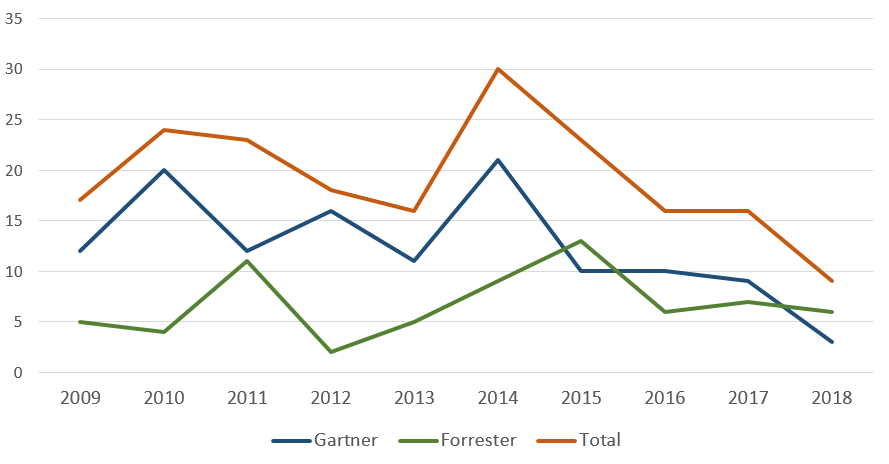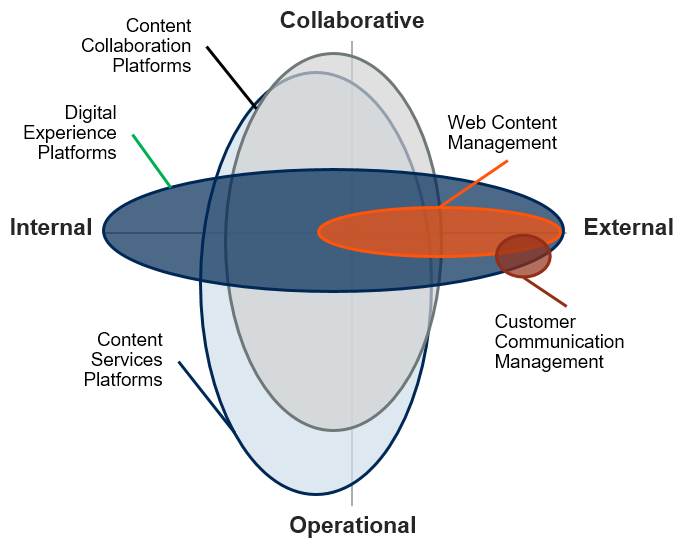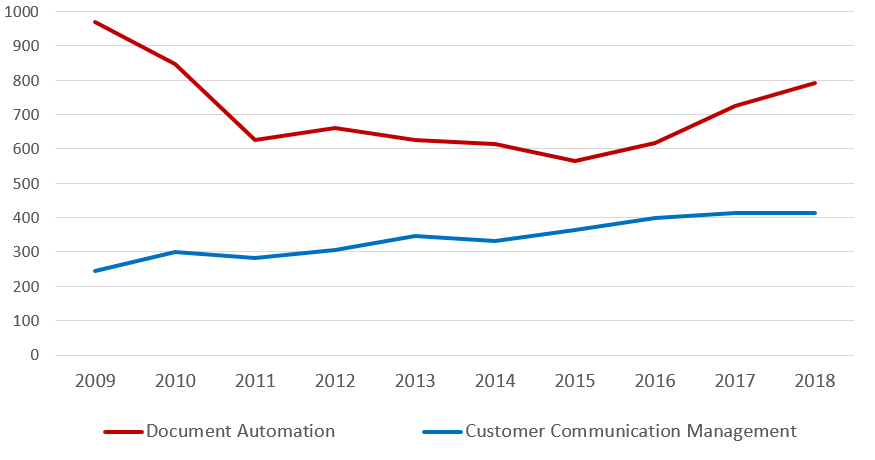When selecting new technology, buyers often look for more objective coverage of the document automation space than what any vendors, however well intentioned, can provide. In many areas, it is the role of technology analysts to provide an impartial point of view, give guidance, and create reports.
As far as the three major analyst companies go – Gartner, Forrester, and IDC – none of them have ever covered the area of document automation.
For example, this is a response we got from Gartner when attempting to find somebody to talk to about document automation or at least review some research:
"In regards to the deep dive into the analysts’ coverage area and research we weren’t able to find anything specific in regards to document automation."
Nick Burgess, Technology CEO Partner at Gartner.
Analyst coverage of document automation
They did in the past cover Customer Communications Management (CCM) or DOCCM, in Forrester's terminology. Document automation and CCM in part overlap, but their core functions differ. The former focuses on generation of documents, while the latter specializes in management of communications. We talked more in-depth about their differences here.
However, CCM is covered no longer. Forrester's last "DOCCM Wave" was released in 2014. The most recent coverage of CCM by IDC is from 2017. Gartner released their last CCM Magic Quadrant in 2017 as well.
None of these analyst companies indicate that CCM – or document automation – is on their upcoming research agenda.
Let’s have a look at how frequently the term "CCM" appears in the analyst research.
The graph below shows the number of research pieces containing the term "CCM" that Gartner and Forrester’s own search engines can find.
Number of analyst research pieces referencing CCM

Figure 1: Number of research pieces (articles, reports, graphics) by analysts in each year over a 10-year period, 2009-2018.
This data is based on each analyst's search engine (Gartner: https://www.gartner.com/en/search; Forrester: https://www.forrester.com/search). Please note that IDC's search only goes back to 2016, so we couldn't use it in this comparison.
This shows that analyst interest peaked around the year 2014, and has steadily declined since.
It's interesting to see what the analysts who worked on CCM do now.
At Gartner, Peter Basiliere focuses on 3D printing. Karen M. Shegda left the company, and her role in CCM research has not been filled. The analysts who covered CCM at IDC and Forrester now primarily cover Robotic Process Automation (RPA) and the future of workplace.
The latest Gartner prediction piece in the area of Content Services clearly shows their analyst perception: CCM is an adjunct to, soon to be absorbed by, digital experience and web content management platforms.

Figure 2: Gartner’s prediction is that Customer Communication Management is going to be almost entirely absorbed by other areas in 2022. © Gartner 2019
Analyst research versus market interest
How does research coverage by analysts compare to the worldwide interest in the topic of document automation and CCM?
This can be measured by looking at Google Trends. We looked at these trends for the same 10-year period 2009-2018, as in the previous graph (Figure 1).
Relative popularity of terms "Document Automation" and "Customer Communication Management" on Google

Figure 3: Relative popularity of search terms "Document Automation" and "Customer Communication Management" on Google over a 10-year period, 2009-2018.
Google’s original data can be found here.
This shows that interest in "document automation" and "customer communication management" has increased steadily from 2015.
This is in direct contrast to the decrease in coverage of CCM by analysts, and no coverage of document automation at all.
This leaves buyers, decision makers, and enterprise architects who look for objective information about document automation (or CCM) empty-handed.
Buyers need to educate themselves based on information provided by vendors. They need to review a number of products that may not be a good fit for their requirements. This process is time-consuming for buyers and vendors alike.
Buyers' options
For our part, we try to help prospective clients understand the document automation space through open dialog when they reach out to us, and suggest they review our guide to document automation.
We’re transparent about what our software does, and make sure that prospects have full understanding that ActiveDocs can't solve every issue and meet every requirement – but when they ask, we’ll join them on the journey and get as close as we can to those solutions.
We help prospective clients understand what our core strengths are – we offer a highly capable document engine which can be run by business users, and seamlessly integrated into the landscape of an organization’s enterprise software applications by IT.
We appreciate that there are vendors whose core strengths are in areas that may interface with document generation – like document management, workflow/BPM, or web forms – and we suggest that if that's what the prospective client is looking for, they investigate these areas of interest.
That doesn't mean we can be completely objective. As ActiveDocs, we are most familiar with our own product.
The question remains – considering that every organization, and every business unit needs to create documents, communications, and new content – why isn’t automation of their creation covered by technology analyst research?
We would like to challenge Gartner, Forrester, and IDC to recognize this enormous market, and bring in clarity and more objective points of views into the document automation landscape.
How do analysts view document automation?
Based on our interactions with analysts, document automation is perceived as something that is already built into pretty much every product that needs to generate documents. This may be a contract management system, a workflow product, web forms, or even specialized applications for HR management, banking, insurance and other verticals and industries.
It’s true, a number of those applications do have the ability to generate documents and other communications.
However, the document automation capability in these applications is on the periphery of their product and development teams. By necessity. Their focus needs to be on their core competency, not on "the adjunct".
Document capability is limited to solution-specific documents and communications that relate to their core capability. Anything outside of this is either impossible to generate, or requires onerous customization.
How about enterprise architects in large organizations?
In many cases, this built-in document generation capability can be sufficient. If it isn’t, there is always a workaround – manual creation.
Some organizations have limited technology expertise in-house, or limited appetite to implement integrated solutions.
In larger businesses, you may end up with a number of systems, each with different ways in which document templates need to be configured, not to mention the impossibility of sharing of any documents or content modules across different systems.
Wise organizations tend to take a more strategic approach. They look for sets of software capabilities that can be utilized across the business, as opposed to having functionality duplicated in a number separate, siloed applications.
Document automation provides universal, organization-wide document and communication generation capability, controlled from one place and seamlessly integrated with everything that needs it.





